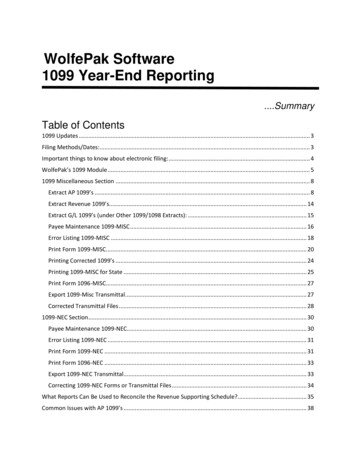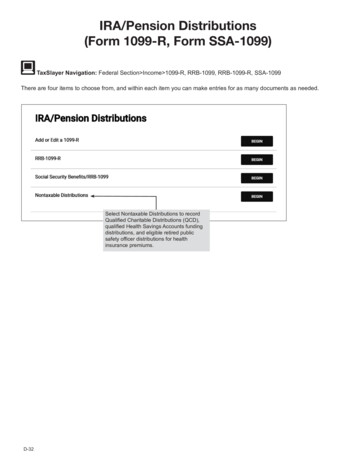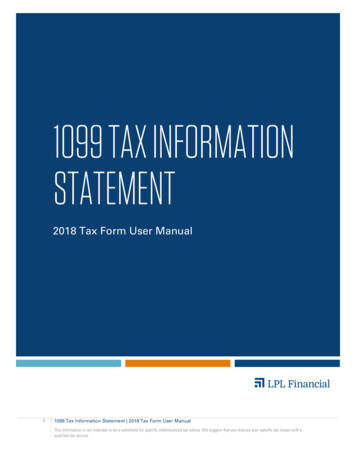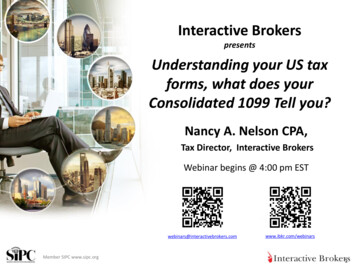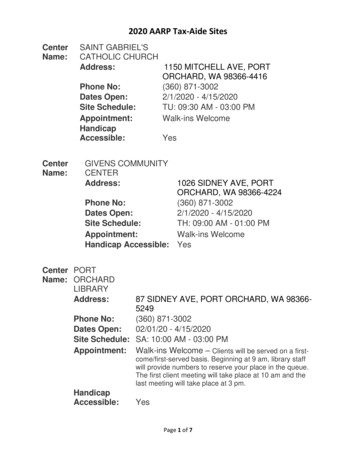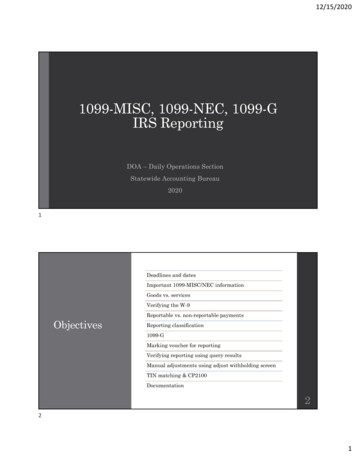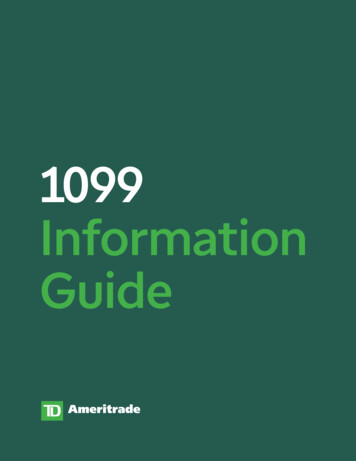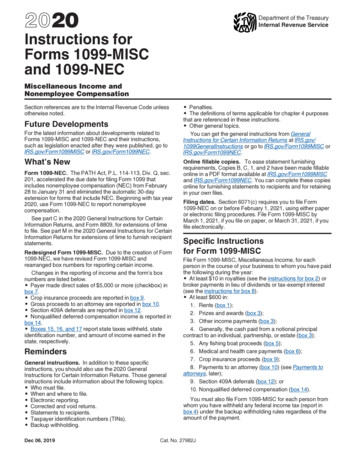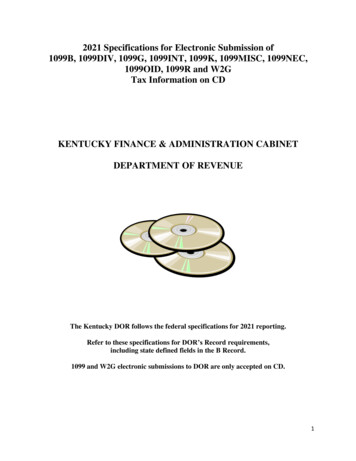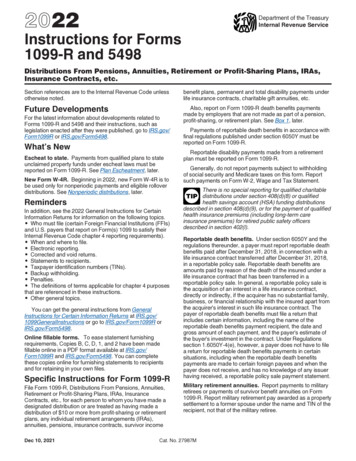
Transcription
2022Department of the TreasuryInternal Revenue ServiceInstructions for Forms1099-R and 5498Distributions From Pensions, Annuities, Retirement or Profit-Sharing Plans, IRAs,Insurance Contracts, etc.Section references are to the Internal Revenue Code unlessotherwise noted.benefit plans, permanent and total disability payments underlife insurance contracts, charitable gift annuities, etc.Future DevelopmentsAlso, report on Form 1099-R death benefits paymentsmade by employers that are not made as part of a pension,profit-sharing, or retirement plan. See Box 1, later.For the latest information about developments related toForms 1099-R and 5498 and their instructions, such aslegislation enacted after they were published, go to IRS.gov/Form1099R or IRS.gov/Form5498.What’s NewEscheat to state. Payments from qualified plans to stateunclaimed property funds under escheat laws must bereported on Form 1099-R. See Plan Escheatment, later.New Form W-4R. Beginning in 2022, new Form W-4R is tobe used only for nonperiodic payments and eligible rolloverdistributions. See Nonperiodic distributions, later.RemindersIn addition, see the 2022 General Instructions for CertainInformation Returns for information on the following topics. Who must file (certain Foreign Financial Institutions (FFIs)and U.S. payers that report on Form(s) 1099 to satisfy theirInternal Revenue Code chapter 4 reporting requirements). When and where to file. Electronic reporting. Corrected and void returns. Statements to recipients. Taxpayer identification numbers (TINs). Backup withholding. Penalties. The definitions of terms applicable for chapter 4 purposesthat are referenced in these instructions. Other general topics.You can get the general instructions from GeneralInstructions for Certain Information Returns at IRS.gov/1099GeneralInstructions or go to IRS.gov/Form1099R orIRS.gov/Form5498.Online fillable forms. To ease statement furnishingrequirements, Copies B, C, D, 1, and 2 have been madefillable online in a PDF format available at IRS.gov/Form1099R and IRS.gov/Form5498. You can completethese copies online for furnishing statements to recipientsand for retaining in your own files.Specific Instructions for Form 1099-RFile Form 1099-R, Distributions From Pensions, Annuities,Retirement or Profit-Sharing Plans, IRAs, InsuranceContracts, etc., for each person to whom you have made adesignated distribution or are treated as having made adistribution of 10 or more from profit-sharing or retirementplans, any individual retirement arrangements (IRAs),annuities, pensions, insurance contracts, survivor incomeDec 10, 2021Payments of reportable death benefits in accordance withfinal regulations published under section 6050Y must bereported on Form 1099-R.Reportable disability payments made from a retirementplan must be reported on Form 1099-R.Generally, do not report payments subject to withholdingof social security and Medicare taxes on this form. Reportsuch payments on Form W-2, Wage and Tax Statement.There is no special reporting for qualified charitableTIP distributions under section 408(d)(8) or qualifiedhealth savings account (HSA) funding distributionsdescribed in section 408(d)(9), or for the payment of qualifiedhealth insurance premiums (including long-term careinsurance premiums) for retired public safety officersdescribed in section 402(l).Reportable death benefits. Under section 6050Y and theregulations thereunder, a payer must report reportable deathbenefits paid after December 31, 2018, in connection with alife insurance contract transferred after December 31, 2018,in a reportable policy sale. Reportable death benefits areamounts paid by reason of the death of the insured under alife insurance contract that has been transferred in areportable policy sale. In general, a reportable policy sale isthe acquisition of an interest in a life insurance contract,directly or indirectly, if the acquirer has no substantial family,business, or financial relationship with the insured apart fromthe acquirer's interest in such life insurance contract. Thepayer of reportable death benefits must file a return thatincludes certain information, including the name of thereportable death benefits payment recipient, the date andgross amount of each payment, and the payer's estimate ofthe buyer's investment in the contract. Under Regulationssection 1.6050Y-4(e), however, a payer does not have to filea return for reportable death benefits payments in certainsituations, including when the reportable death benefitspayments are made to certain foreign payees and when thepayer does not receive, and has no knowledge of any issuerhaving received, a reportable policy sale payment statement.Military retirement annuities. Report payments to militaryretirees or payments of survivor benefit annuities on Form1099-R. Report military retirement pay awarded as a propertysettlement to a former spouse under the name and TIN of therecipient, not that of the military retiree.Cat. No. 27987M
another contract of endowment insurance that provides forregular payments to begin no later than they would havebegun under the old contract, or for an annuity contract, or fora qualified long-term care insurance contract; or (c) anannuity contract for an annuity contract or for a qualifiedlong-term care insurance contract; or (d) a qualifiedlong-term care insurance contract for a qualified long-termcare insurance contract. A contract shall not fail to be treatedas an annuity contract or as a life insurance contract solelybecause a qualified long-term care insurance contract is apart of or a rider on such contract. However, the distributionof other property or the cancellation of a contract loan at thetime of the exchange may be taxable and reportable on aseparate Form 1099-R.These exchanges of contracts are generally reportable onForm 1099-R. However, reporting on Form 1099-R is notrequired if (a) the exchange occurs within the samecompany; (b) the exchange is solely a contract for contractexchange, as defined above, that does not result in adesignated distribution; and (c) the company maintainsadequate records of the policyholder's basis in the contracts.For example, a life insurance contract issued by Company Xreceived in exchange solely for another life insurancecontract previously issued by Company X does not have tobe reported on Form 1099-R as long as the companymaintains the required records. See Rev. Proc. 92-26,1992-1 C.B. 744, for certain exchanges for which reporting isnot required under section 6047(d). Also, see Rev. Rul.2007-24, 2007-21 I.R.B. 1282, available at IRS.gov/irb/2007-21 IRB#RR-2007-24, for certain transactions that donot qualify as tax-free exchanges. For more information onpartial exchanges of annuity contracts, see Rev. Proc.2011-38, 2011-30 I.R.B. 66, available at IRS.gov/irb/2011-30 IRB#RP-2011-38.Regulations under section 6050Y provide that a section1035 exchange constitutes a reportable policy sale in limitedcircumstances. Death benefits paid by reason of the death ofthe insured under the life insurance contract issued in suchcircumstances are reportable death benefits that must bereported on Form 1099-R.For more information on reporting taxable exchanges, seeBox 1, later.Use Code 7 in box 7 for reporting military pensions orsurvivor benefit annuities. Use Code 4 for reportingCAUTION death benefits paid to a survivor beneficiary on aseparate Form 1099-R. Do not combine with any othercodes.!Governmental section 457(b) plans. Report on Form1099-R, not Form W-2, income tax withholding anddistributions from a section 457(b) plan maintained by a stateor local government employer. Distributions from agovernmental section 457(b) plan to a participant orbeneficiary include all amounts that are paid from the plan.For more information, see Notice 2003-20 on page 894 ofInternal Revenue Bulletin 2003-19 at IRS.gov/pub/irs-irbs/irb03-19.pdf. Also, see Governmental section 457(b) plandistributions, later, for information on distribution codes.Nonqualified plans. Report any reportable distributionsfrom commercial annuities. Report distributions to employeeplan participants from section 409A nonqualified deferredcompensation plans and eligible nongovernmental section457(b) plans on Form W-2, not on Form 1099-R; fornonemployees, these payments are reportable on Form1099-NEC. Report distributions to beneficiaries of deceasedplan participants on Form 1099-MISC. See the Instructionsfor Forms 1099-MISC and 1099-NEC for more information.Section 404(k) dividends. Distributions of section 404(k)dividends from an employee stock ownership plan (ESOP),including a tax credit ESOP, are reported on Form 1099-R.Distributions other than section 404(k) dividends from theplan must be reported on a separate Form 1099-R.Section 404(k) dividends paid directly from thecorporation to participants or their beneficiaries are reportedon Form 1099-DIV. See Announcement 2008-56, 2008-26I.R.B. 1192, available at IRS.gov/irb/2008-26 IRB#ANN-2008-56.Charitable gift annuities. If cash or capital gain property isdonated in exchange for a charitable gift annuity, reportdistributions from the annuity on Form 1099-R. SeeCharitable gift annuities, later.Life insurance, annuity, and endowment contracts.Report payments of matured or redeemed annuity,endowment, and life insurance contracts. However, you donot need to file Form 1099-R to report the surrender of a lifeinsurance contract if it is reasonable to believe that none ofthe payment is includible in the income of the recipient. If youare reporting the surrender of a life insurance contract, seeCode 7, later. See, however, Box 1, later, for FFIs reporting ina manner similar to section 6047(d) for the purposes ofchapter 4 of the Internal Revenue Code.Report premiums paid by a trustee or custodian for thecost of current life or other insurance protection. Costs ofcurrent life insurance protection are not subject to the 10%additional tax under section 72(t). See Cost of current lifeinsurance protection, later.Report charges or payments for a qualified long-term careinsurance contract against the cash value of an annuitycontract or the cash surrender value of a life insurancecontract, which is excludable from gross income undersection 72(e)(11). See Code W, later.Section 1035 exchange. A tax-free section 1035exchange is the exchange of (a) a life insurance contract foranother life insurance contract, or for an endowment orannuity contract, or for a qualified long-term care insurancecontract; or (b) a contract of endowment insurance forProhibited transactions. If an IRA owner engages in aprohibited transaction with respect to an IRA, the assets ofthe IRA are treated as distributed on the first day of the taxyear in which the prohibited transaction occurs. IRAs thathold non-marketable securities and/or closely heldinvestments, in which the IRA owner effectively controls theunderlying assets of such securities or investments, have agreater potential for resulting in a prohibited transaction.Enter Code 5 in box 7.Designated Roth Account ContributionsAn employer offering a section 401(k), 403(b), orgovernmental section 457(b) plan may allow participants tocontribute all or a portion of the elective deferrals they areotherwise eligible to make to a separate designated Rothaccount established under the plan. Contributions madeunder a section 401(k) plan must meet the requirements ofRegulations section 1.401(k)-1(f) (Regulations section1.403(b)-3(c) for a section 403(b) plan). Under the terms ofthe section 401(k) plan, section 403(b) plan, or governmentalsection 457(b) plan, the designated Roth account must meetthe requirements of section 402A.-2-Instructions for Forms 1099-R and 5498 (2022)
!CAUTIONA separate Form 1099-R must be used to report thetotal annual distribution from a designated Rothaccount.Roth IRA conversions. You must report a traditional, SEP,or SIMPLE IRA distribution that you know is converted thisyear to a Roth IRA in boxes 1 and 2a (checking box 2b“Taxable amount not determined” unless otherwise directedelsewhere in these instructions), even if the conversion is atrustee-to-trustee transfer or is with the same trustee. EnterCode 2 or 7 in box 7 depending on the participant's age.Distributions allocable to an in-plan Roth rollover (IRR).The distribution of an amount allocable to the taxable amountof an IRR, made within the 5-year period beginning with thefirst day of the participant’s tax year in which the rollover wasmade, is treated as includible in gross income for purposes ofapplying section 72(t) to the distribution. The total amountallocable to such an IRR is reported in box 10. See theinstructions for Box 10, later. An IRR is a rollover within aretirement plan to a designated Roth account in the sameplan. See Notice 2010-84, 2010-51 I.R.B. 872, available atIRS.gov/irb/2010-51 IRB#NOT-2010-84, as modified byNotice 2013-74, 2013-52 I.R.B. 819, available at IRS.gov/irb/2013-52 IRB#NOT-2013-74.IRA escheatment. Payments made from IRAs to stateunclaimed property funds must be reported on Form 1099-R.See Rev. Rul. 2018-17, 2018-25 I.R.B. 753, available atIRS.gov/irb/2018-25 IRB#RR-2018-17, as modified byNotice 2018-90, 2018-49 I.R.B. 826, available at IRS.gov/irb/2018-49 IRB#NOT-2018-90.IRA Revocation or Account ClosureIf a traditional or Roth IRA is revoked during its first 7 days(under Regulations section 1.408-6(d)(4)(ii)) or is closed atany time by the IRA trustee or custodian due to a failure ofthe taxpayer to satisfy the Customer Identification Programrequirements described in section 326 of the USA PATRIOTAct, the distribution from the IRA must be reported. Inaddition, Form 5498, IRA Contribution Information, must befiled to report any regular, rollover, Roth IRA conversion, SEPIRA, or SIMPLE IRA contribution to an IRA that issubsequently revoked or closed by the trustee or custodian.IRA DistributionsFor deemed IRAs under section 408(q), use the rulesTIP that apply to traditional IRAs or Roth IRAs, asapplicable. Simplified employee pension (SEP) IRAsand savings incentive match plan for employees (SIMPLE)IRAs, however, may not be used as deemed IRAs.Deemed IRAs. For more information on deemed IRAs inqualified employer plans, see Regulations section1.408(q)-1.If a regular contribution is made to a traditional or Roth IRAthat is later revoked or closed, and a distribution is made tothe taxpayer, enter the gross distribution in box 1. If noearnings are distributed, enter 0 (zero) in box 2a and Code 8in box 7 for a traditional IRA and Code J for a Roth IRA. Ifearnings are distributed, enter the amount of earnings inbox 2a. For a traditional IRA, enter Codes 1 and 8, ifapplicable, in box 7; for a Roth IRA, enter Codes J and 8, ifapplicable. These earnings could be subject to the 10% earlydistribution tax under section 72(t). If a rollover contribution ismade to a traditional or Roth IRA that is later revoked orclosed, and distribution is made to the taxpayer, enter inboxes 1 and 2a of Form 1099-R the gross distribution and theappropriate code in box 7 (Code J for a Roth IRA). Followthis same procedure for a transfer from a traditional or RothIRA to another IRA of the same type that is later revoked orclosed. The distribution could be subject to the 10% earlydistribution tax under section 72(t).IRAs other than Roth IRAs. Unless otherwise instructed,distributions from any IRA that is not a Roth IRA must bereported in boxes 1 and 2a. Check the “Taxable amount notdetermined” box in box 2b. But see: Traditional, SEP, or SIMPLE IRA, later, for how to reportthe withdrawal of IRA contributions under section 408(d)(4); Transfers, later, for information on trustee-to-trusteetransfers, including recharacterizations; Traditional, SEP, or SIMPLE IRA, later, for reporting acorrective distribution from an IRA under section 408(d)(5); IRA Revocation or Account Closure, later, for reportingIRA revocations or account closures due to CustomerIdentification Program failures; and Traditional, SEP, or SIMPLE IRA, later, for reporting atransfer from a SIMPLE IRA to a non-SIMPLE IRA within thefirst 2 years of plan participation.The direct rollover provisions beginning later do not applyto distributions from any IRA. However, taxable distributionsfrom traditional IRAs and SEP IRAs may be rolled over intoan eligible retirement plan. See section 408(d)(3). SIMPLEIRAs may also be rolled over into an eligible retirement plan,but only after the first 2 years of plan participation.An IRA includes all investments under one IRA plan oraccount. File only one Form 1099-R for distributions from allinvestments under one plan that are paid in 1 year to onerecipient, unless you must enter different codes in box 7. Youdo not have to file a separate Form 1099-R for eachdistribution under the plan.If an IRA conversion contribution or a rollover from aqualified plan is made to a Roth IRA that is later revoked orclosed, and a distribution is made to the taxpayer, enter thegross distribution in box 1 of Form 1099-R. If no earnings aredistributed, enter 0 (zero) in box 2a and Code J in box 7. Ifearnings are distributed, enter the amount of the earnings inbox 2a and Code J in box 7. These earnings could be subjectto the 10% early distribution tax under section 72(t).If an employer SEP IRA or SIMPLE IRA plan contributionis made and the SEP IRA or SIMPLE IRA is revoked by theemployee or is closed by the trustee or custodian, report thedistribution as fully taxable.Roth IRAs. For distributions from a Roth IRA, report thegross distribution in box 1 but generally leave box 2a blank.Check the “Taxable amount not determined” box in box 2b.Enter Code J, Q, or T, as appropriate, in box 7. Do not useany other codes with Code Q or Code T. You may enterCode 8 or P with Code J. For the withdrawal of excesscontributions, see Roth IRA, later. It is not necessary to markthe IRA/SEP/SIMPLE checkbox.Instructions for Forms 1099-R and 5498 (2022)For more information on IRAs that have been revoked,see Rev. Proc. 91-70, 1991-2 C.B. 899.Plan EscheatmentPayments made from qualified plans on or after January 1,2022, to state unclaimed property funds must be reported onForm 1099-R. See Rev. Rul. 2020-24, 2020-45 I.R.B. 965,available at IRS.gov/irb/2020-45 IRB#REV-RUL-2020-24.-3-
Deductible Voluntary Employee Contributions(DVECs)401(k)) and excess aggregate contributions (under section401(m)) and earnings.6. Loans treated as deemed distributions (under section72(p)). However, qualified plan loan offset amounts and planloan offset amounts can be eligible rollover distributions. Seesection 402(c)(3)(C) and Regulations section 1.402(c)-2,Q/A-9 and Plan Loan Offsets, later.7. Section 404(k) dividends.8. Cost of current life insurance protection.9. Distributions to a payee other than the employee, theemployee's surviving spouse, a spouse or former spousewho is an alternate payee under a QDRO, or a nonspousedesignated beneficiary.10. Any hardship distribution.11. A permissible withdrawal under section 414(w).12. Prohibited allocations of securities in an S corporationthat are treated as deemed distributions.13. Distributions of premiums for accident or healthinsurance under Regulations section 1.402(a)-1(e).If you are reporting a total distribution from a plan thatincludes a distribution of DVECs, you may file a separateForm 1099-R to report the distribution of DVECs. If you do,report the distribution of DVECs in boxes 1 and 2a on theseparate Form 1099-R. For the direct rollover (explainedlater) of funds that include DVECs, a separate Form 1099-Ris not required to report the direct rollover of the DVECs.Direct RolloversYou must report a direct rollover of an eligible rolloverdistribution. A direct rollover is the direct payment of thedistribution from a qualified plan, a section 403(b) plan, or agovernmental section 457(b) plan to a traditional IRA, RothIRA, or other eligible retirement plan. For additional rulesregarding the treatment of direct rollovers from designatedRoth accounts, see Designated Roth accounts, later. A directrollover may be made for the employee, for the employee'ssurviving spouse, for the spouse or former spouse who is analternate payee under a qualified domestic relations order(QDRO), or for a nonspouse designated beneficiary, in whichcase the direct rollover can only be made to an inherited IRA.If the distribution is paid to the surviving spouse, thedistribution is treated in the same manner as if the spousewere the employee. See Part V of Notice 2007-7, 2007-5I.R.B. 395, available at IRS.gov/irb/2007-05 IRB#NOT-2007-7, which has been modified byNotice 2009-82, 2009-41 I.R.B. 491, available at IRS.gov/irb/2009-41 IRB#NOT-2009-82, and Notice 2020-51, 2020-29I.R.B. 73, available at IRS.gov/irb/2020-29 IRB#NOT-2020-51, for guidance on direct rolloversby nonspouse designated beneficiaries. Also, see Notice2008-30, Part II, 2008-12 I.R.B. 638, available at IRS.gov/irb/2008-12 IRB#NOT-2008-30, which has been amplified andclarified by Notice 2009-75, 2009-39 I.R.B. 436, available atIRS.gov/irb/2009-39 IRB#NOT-2009-75, for questions andanswers covering rollover contributions to Roth IRAs.Amounts paid under an annuity contract purchased forand distributed to a participant under a qualified plan canqualify as eligible rollover distributions. See Regulationssection 1.402(c)-2, Q/A-10.Automatic rollovers. Eligible rollover distributions may alsoinclude involuntary distributions that are more than 1,000but not more than 5,000 and are made from a qualified planto an IRA on behalf of a plan participant. Involuntarydistributions are generally subject to the automatic rolloverprovisions of section 401(a)(31)(B) and must be paid in adirect rollover to an IRA, unless the plan participant elects tohave the rollover made to another eligible retirement plan orto receive the distribution directly.For information on the notification requirements, seeExplanation to Recipients Before Eligible RolloverDistributions (Section 402(f) Notice), later. For additionalinformation, also see Notice 2005-5, 2005-3 I.R.B. 337,available at IRS.gov/irb/2005-03 IRB#NOT-2005-5, asmodified by Notice 2005-95, 2005-51 I.R.B. 1172, availableat IRS.gov/irb/2005-51 IRB#NOT-2005-95.An eligible rollover distribution is any distribution of all orany portion of the balance to the credit of the employee(including net unrealized appreciation (NUA)) from a qualifiedplan, a section 403(b) plan, or a governmental section 457(b)plan except the following.1. One of a series of substantially equal periodicpayments made at least annually over:a. The life of the employee or the joint lives of theemployee and the employee's designated beneficiary,b. The life expectancy of the employee or the joint lifeand last survivor expectancy of the employee and theemployee's designated beneficiary, orc. A specified period of 10 years or more.2. A required minimum distribution (RMD) under section401(a)(9). A plan administrator is permitted to assume thereis no designated beneficiary for purposes of determining theminimum distribution.3. Elective deferrals (under section 402(g)(3)) andemployee contributions (including earnings on each)returned because of the section 415 limits.4. Corrective distributions of excess deferrals (undersection 402(g)) and earnings.5. Corrective distributions of excess contributions undera qualified cash or deferred arrangement (under sectionReporting a direct rollover. Report a direct rollover inbox 1 and a 0 (zero) in box 2a, unless the rollover is a directrollover of a qualified rollover contribution other than from adesignated Roth account. See Qualified rollovercontributions as defined in section 408A(e), later. You do nothave to report capital gain in box 3 or NUA in box 6. EnterCode G in box 7 unless the rollover is a direct rollover from adesignated Roth account to a Roth IRA. See DesignatedRoth accounts, later. If the direct rollover is made by anonspouse designated beneficiary, also enter Code 4 inbox 7.Prepare the form using the name and social securitynumber (SSN) of the person for whose benefit the fundswere rolled over (generally, the participant), not those of thetrustee of the traditional IRA or other plan to which the fundswere rolled.If part of the distribution is a direct rollover and part isdistributed to the recipient, prepare two Forms 1099-R.For guidance on allocation of after-tax amounts torollovers, see Notice 2014-54, 2014-41 I.R.B. 670, availableat IRS.gov/irb/2014-41 IRB#NOT-2014-54.-4-Instructions for Forms 1099-R and 5498 (2022)
box 2a, and any basis recovery amount in box 5. Use CodeG in box 7.Qualified rollover contributions as defined in section408A(e). A qualified rollover contribution as defined insection 408A(e) is: A rollover contribution to a Roth IRA from another IRA thatmeets the requirements of section 408(d)(3), or A rollover contribution to a Roth IRA from an eligibleretirement plan (other than an IRA) that meets therequirements of section 408A(e)(1)(B).For reporting a rollover from an IRA other than a Roth IRAto a Roth IRA, see Roth IRA conversions, earlier and later.For a direct rollover of an eligible rollover distribution to aRoth IRA (other than from a designated Roth account), reportthe total amount rolled over in box 1, the taxable amount inbox 2a, and any basis recovery amount in box 5. (See theinstructions for Box 5, later.) Use Code G in box 7. If thedirect rollover is made on behalf of a nonspouse designatedbeneficiary, also enter Code 4 in box 7.For reporting instructions for a direct rollover from adesignated Roth account, see Designated Roth accounts,earlier.For more information on eligible rollover distributions,including substantially equal periodic payments, RMDs, andplan loan offset amounts, see Regulations sections1.402(c)-2 and 1.403(b)-7(b). See Rev. Rul. 2014-9, 2014-17I.R.B. 975, available at IRS.gov/irb/2014-17 IRB#RR-2014-9, for information on rollovers toqualified plans. Also, see Rev. Rul. 2002-62, which is onpage 710 of Internal Revenue Bulletin 2002-42 atIRS.gov/pub/irs-irbs/irb02-42.pdf, for guidance onsubstantially equal periodic payments.For information on distributions of amountsTIP attributable to rollover contributions separatelyaccounted for by an eligible retirement plan and ifpermissible timing restrictions apply, see Rev. Rul. 2004-12,2004-7 I.R.B. 478, available at IRS.gov/irb/2004-07 IRB#RR-2004-12, as modified by Notice 2013-74,2013-52 I.R.B. 819, available at IRS.gov/irb/2013-52 IRB#NOT-2013-74.Designated Roth accounts. A direct rollover from adesignated Roth account may only be made to anotherdesignated Roth account or to a Roth IRA. A distribution froma Roth IRA, however, cannot be rolled over into a designatedRoth account. In addition, a plan is permitted to treat thebalance of the participant's designated Roth account and theparticipant's other accounts under the plan as accounts heldunder two separate plans for purposes of applying theautomatic rollover rules of section 401(a)(31)(B) and Q/A-9through Q/A-11 of Regulations section 1.401(a)(31)-1. Thus,if a participant's balance in the designated Roth account isless than 200, the plan is not required to offer a directrollover election or to apply the automatic rollover provisionsto such balance.A distribution from a designated Roth account that is aqualified distribution is tax free. A qualified distribution is apayment that is made both after age 591/2 (or after death ordisabililty) and after the 5-tax-year period that begins with thefirst day of the first tax year in which the employee makes acontribution to the designated Roth account. Certainamounts, including corrective distributions, cannot bequalified distributions. See Regulations section 1.402A-1.If any portion of a distribution from a designated Rothaccount that is not includible in gross income is to be rolledover into a designated Roth account under another plan, therollover must be accomplished by a direct rollover. Anyportion not includible in gross income that is distributed to theemployee, however, cannot be rolled over to anotherdesignated Roth account, though it can be rolled over into aRoth IRA within the 60-day period described in section402(c)(3). In the case of a direct rollover, the distributing planis required to report to the recipient plan the amount of theinvestment (basis) in the contract and the first year of the5-tax-year period, or that the distribution is a qualifieddistribution.For a direct rollover of a distribution from a designatedRoth account to a Roth IRA, enter the amount rolled over inbox 1 and 0 (zero) in box 2a. Use Code H in box 7. For allother distributions from a designated Roth account, useCode B in box 7, unless Code E applies. If the direct rolloveris from one designated Roth account to another designatedRoth account, also enter Code G in box 7.For a direct rollover of a distribution from a section 401(k)plan, a section 403(b) plan, or a governmental section 457(b)plan to a designated Roth account in the same plan, enterthe amount rolled over in box 1, the taxable amount inInstructions for Forms 1099-R and 5498 (2022)Explanation to Recipients Before EligibleRollover Distributions (Section 402(f) Notice)For qualified plans, section 403(b) plans, and governmentalsection 457(b) plans, the plan administrator must provide toeach recipient of an eligible rollover distribution anexplanation using either a written paper document or anelectronic medium (section 402(f) notice). The explanationmust be provided no more than 180 days and no fewer than30 days before making an eligible rollover distribution orbefore the annuity starting date. However, if the recipient whohas received the section 402(f) notice affirmatively elects adistribution, you will not fail to satisfy the timing requirementsmerely because you make the distribution fewer than 30 daysafter you provided the notice as long as you meet therequirements of R
Charitable gift annuities. If cash or capital gain property is donated in exchange for a charitable gift annuity, report distributions from the annuity on Form 1099-R. See Charitable gift annuities, later. Life insurance, annuity, and endowment contracts. Report payments of matured or redeemed annuity, endowment, and life insurance contracts.
